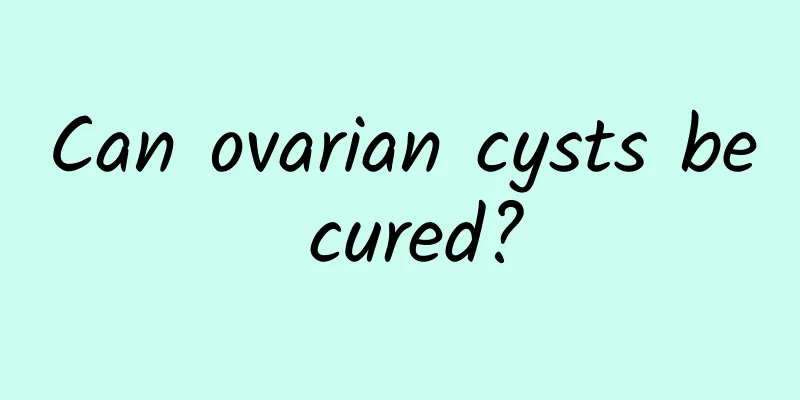What are the clinical manifestations of functional uterine bleeding?

|
What are the clinical manifestations of functional uterine bleeding? You may be unfamiliar with the phenomenon of functional uterine bleeding in life, but it is a common gynecological disease with a high clinical incidence rate, which can cause female infertility. Therefore, we need to know more about this disease to prevent unnecessary harm. Let's take a look at the clinical manifestations of functional uterine bleeding. 1. Anovulatory functional uterine bleeding is divided into two groups according to age. (I) Dysfunctional uterine bleeding in adolescence: It occurs in girls after menarche. It is caused by the immaturity of the HPOU axis and the inability to establish regular ovulation. Clinical manifestations include infrequent menstruation after menarche, irregular menorrhagia after a short period of amenorrhea, prolonged menstruation, and continuous bleeding, leading to severe anemia. (ii) Menopausal (perimenopausal) functional uterine bleeding: that is, functional uterine bleeding in women aged ≥40 years to around the time of menopause, during which the incidence of anovulatory functional uterine bleeding increases year by year. Clinical manifestations include: frequent menstruation, irregular cycles, excessive menstrual flow, and prolonged menstruation. 10-15% of patients present with severe irregular menstruation, metrorrhagia, and severe anemia. Endometrial biopsy often shows varying degrees of endometrial hyperplasia, so curettage is necessary, and special attention should be paid to excluding non-functional uterine bleeding caused by gynecological tumors (uterine fibroids, endometrial cancer, ovarian cancer, cervical cancer). 2. Ovulatory functional uterine bleeding is most common in women of childbearing age, and is also sometimes seen in adolescent girls and menopausal women. It is clinically divided into the following types: 1. Ovulatory oligomenorrhea: seen in adolescent girls. After menarche, the follicular phase is prolonged, the luteal phase is normal, the cycle is ≥40 days, and the menstruation is oligomenorrhea. It is often a precursor to polycystic ovary. It is rare in menopausal women and often progresses to natural menopause. 2. Ovulatory frequent menstruation: The ovaries of adolescent girls are more sensitive to gonadotropin, which accelerates the development of follicles, shortens the follicular phase, and causes frequent menstruation, but ovulation and luteal phases remain normal. If the patient is a menopausal woman, both the follicular phase and the luteal phase are shortened and early menopause occurs. (II) Luteal dysfunction 1. Luteal insufficiency: premature luteal degeneration, shortened luteal phase ≤ 10 days. Clinical manifestations include frequent menstruation, shortened cycle, premenstrual bleeding and menorrhagia, combined with infertility and early miscarriage. Endometrial pathology is irregular maturation or incomplete secretion. 2. Incomplete luteal atrophy: also known as prolonged luteal function, that is, the corpus luteum cannot completely degenerate within 3 to 5 days, or the degeneration time is prolonged, or a certain amount of progesterone continues to be secreted during the menstrual period, resulting in irregular endometrial shedding. Prolonged menstruation, continuous bleeding, and premature luteal degeneration will manifest as frequent menstruation and menorrhagia. It is more common in patients with uterine fibroids, endometrial polyps and adenomyosis after artificial abortion or induced labor. 3. Mid-menstrual bleeding is also called ovulation bleeding. It is often accompanied by ovulation pain, which is caused by ovulation stimulation and estrogen fluctuations, causing a small amount of bleeding (1 to 3 days) and abdominal pain. In some cases, the bleeding is more severe and continues until the menstrual period, forming frequent pseudomenstruation. Patients should combine work and rest in their daily life, avoid heavy physical work and strenuous activities, get enough sleep, be in a good mood, and eat more fresh fruits and vegetables rich in vitamin C, such as spinach, rapeseed, cabbage, tomatoes, carrots, apples, pears, bananas, oranges, hawthorns, fresh dates, etc. These foods are not only rich in iron and copper, but also contain folic acid, vitamin C and carotene, which have a good effect on treating anemia and assisting in hemostasis. |
<<: How to check for amenorrhea
>>: What are the dietary treatments for vulvar leukoplakia
Recommend
Losing weight by eating less sugar doesn’t just mean candy and snacks! Avoid these 8 foods that are high in sugar
People who are losing weight should be careful ab...
What's wrong with a small amount of menstrual flow and black color?
Menstruation is generally a problem that most wom...
unexpected! There are tips for eating desserts without gaining weight
Regardless of the era, almost all girls try their...
What is the cause of long-term bacterial vaginosis?
What are the causes of long-term bacterial vagino...
How much does menopause surgery cost?
When it comes to the treatment of menopause, many...
Women should be alert to the early symptoms of ectopic pregnancy
Many women will not notice the early stage of ect...
Is it normal for menstruation to come three days early every month? The right way to regulate
Women have their periods every month, and many wo...
What are the dietary treatments for uterine effusion?
The occurrence of uterine effusion brings great i...
Eat beans to lose weight! Red beans, soybeans, and peas are all good
Have you eaten beans today? Legumes such as red b...
Typical symptoms of vaginitis, let's take a look at the experts' introduction
Vaginitis is a common disease among women, so it ...
shock! Study: Excessive intake of soy milk may cause infertility in girls
Soy milk has been a health product since ancient ...
What is the difference between right ovarian cyst and follicle? What are the causes of ovarian cyst?
What is the difference between a right ovarian cy...
How to abort a baby in one week of pregnancy? There are these methods
Some women are not very happy when they know they...
What is vulvar leukoplakia and what to do
Vulvar leukoplakia generally refers to localized ...
What should I do if I have cervical erosion? Is cervical erosion related to sexual life?
What should I do if I have cervical erosion? Is i...









